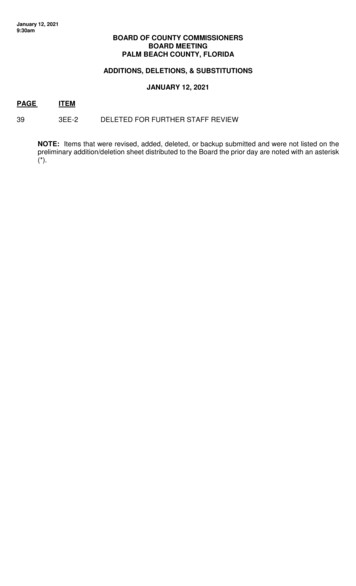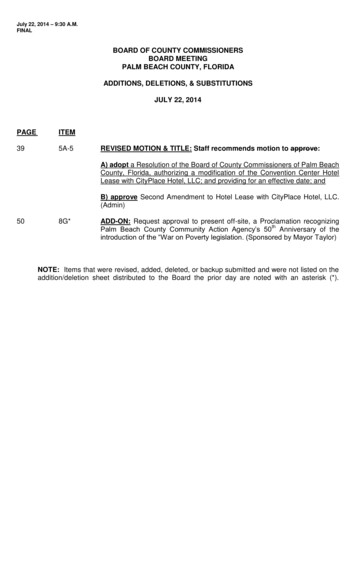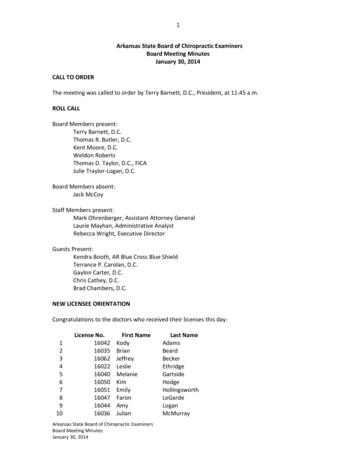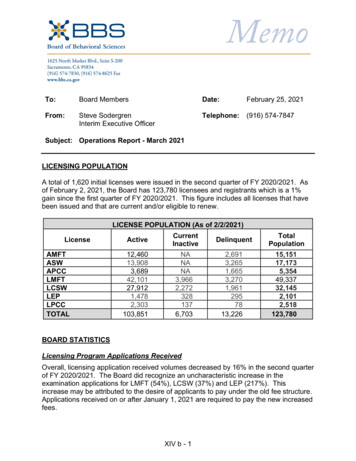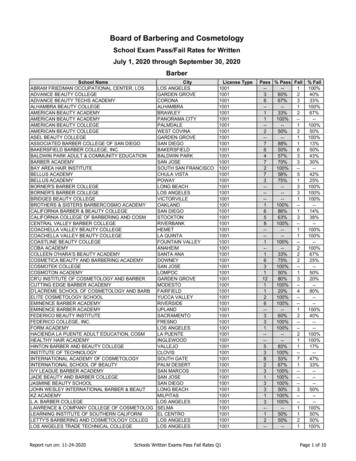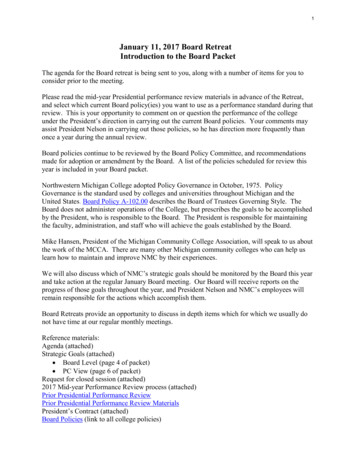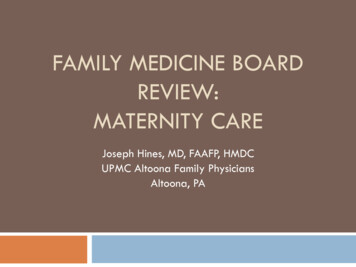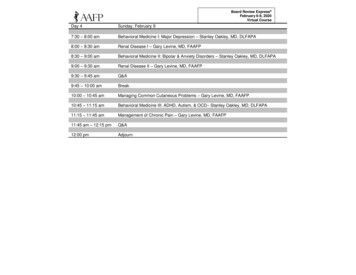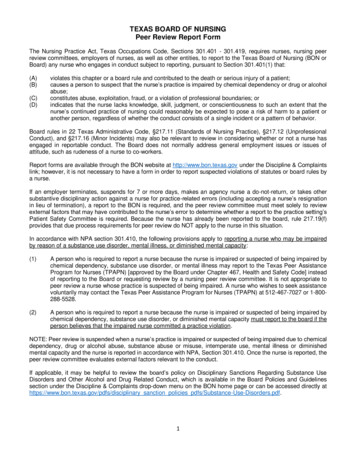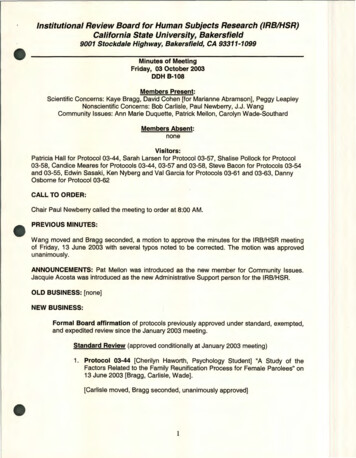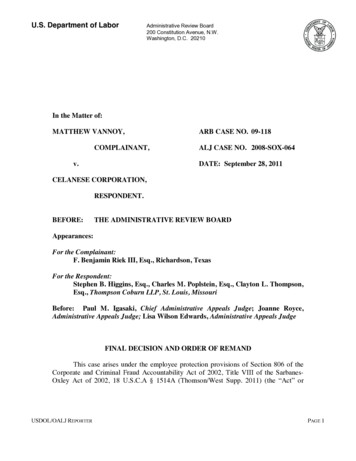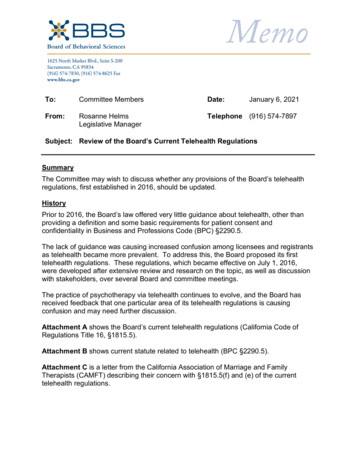
Transcription
To:Committee MembersDate:From:Rosanne HelmsLegislative ManagerTelephone (916) 574-7897January 6, 2021Subject: Review of the Board’s Current Telehealth RegulationsSummaryThe Committee may wish to discuss whether any provisions of the Board’s telehealthregulations, first established in 2016, should be updated.HistoryPrior to 2016, the Board’s law offered very little guidance about telehealth, other thanproviding a definition and some basic requirements for patient consent andconfidentiality in Business and Professions Code (BPC) §2290.5.The lack of guidance was causing increased confusion among licensees and registrantsas telehealth became more prevalent. To address this, the Board proposed its firsttelehealth regulations. These regulations, which became effective on July 1, 2016,were developed after extensive review and research on the topic, as well as discussionwith stakeholders, over several Board and committee meetings.The practice of psychotherapy via telehealth continues to evolve, and the Board hasreceived feedback that one particular area of its telehealth regulations is causingconfusion and may need further discussion.Attachment A shows the Board’s current telehealth regulations (California Code ofRegulations Title 16, §1815.5).Attachment B shows current statute related to telehealth (BPC §2290.5).Attachment C is a letter from the California Association of Marriage and FamilyTherapists (CAMFT) describing their concern with §1815.5(f) and (e) of the currenttelehealth regulations.
Discussion of Regulation §1815.5(f) and (e)Regulation §1815.5(e) states that a California licensee or registrant may only providetelehealth to a client in another jurisdiction if he or she meets the requirements tolawfully provide services in that jurisdiction, and if telehealth is allowed by thatjurisdiction.This subsection was added because often, Board licensees and registrants areunaware that it is common for jurisdictions to require a license to practice with a patientlocated there. To avoid opening themselves up to liability, therapists need to check tomake sure they are following that jurisdiction’s laws before practicing there. Otherwise,that jurisdiction could decide to take disciplinary action if there were a violation. If thejurisdiction decided to take such an action for a violation of their law, it would be withintheir authority to do so because the violation occurred in their jurisdiction.Regulation §1815.5(f) states that failure to comply with any provisions of the Board’stelehealth regulations is unprofessional conduct.CAMFT has raised a concern that making it unprofessional conduct if a therapist fails tocheck to make sure he or she is following the laws of the jurisdiction where the client islocated is too rigid and could lead to unintended consequences. For example, it doesnot necessarily account for a patient who is traveling, a patient who is transitioning to anew therapist, or a patient in crisis. They suggest that the location of 1815.5(e) bemoved to after 1815.5(f) so that it functions as guidance, rather than a requirement thatone must follow to avoid discipline.Whether another jurisdiction decides to take disciplinary action based on a complaintthey receive when a therapist is practicing with a patient in their jurisdiction who istraveling, transitioning, or in crisis is at their discretion and outside of the authority of thisBoard. However, the Board may wish to discuss whether it should require its licenseesto check with the other jurisdiction in which they are practicing or whether that shouldsimply be suggested as guidance.Telehealth GuidanceA significant amount of guidance for telehealth practice has been developed by variousorganizations since the Board adopted its initial telehealth regulations. Some examplesare as follows: Reference D provides the Center for Connected Health Policy’s website thatdiscusses cross-state licensing. This page provides a general overview ofcurrent state efforts. The Association of Marital and Family Therapy Regulatory Boards releasedteletherapy guidelines (Reference E) in 2016.
The American Counseling Association (ACA) and National Association of SocialWorkers (NASW) have resources related to telehealth on their websites(Reference F and Reference G, respectively).RecommendationConduct an open discussion regarding regulation section 1815.5(e), (f), and any otherprovisions of §1815.5 that the Committee believes may require amendments.Attachments/ReferencesAttachment A: Board Regulations: 16 CCR §1815.5: Standards of Practice forTelehealthAttachment B: Statute Relating to Telehealth: BPC §2290.5Attachment C: CAMFT Letter, January 11, 2018Attachment D: Center for Connected Health Policy: Cross-State LicensureAttachment E: Association of Marital and Family Therapy Regulatory Boards(AMFTRB) Teletherapy Guidelines (September 2016)Attachment F: American Counseling Association - Telebehavioral Health InformationAttachment G: National Association of Social Workers – Telemental Health: LegalConsiderations for Social Workers
Blank Page
Attachment ABoard of Behavioral SciencesCurrent Telehealth RegulationsCalifornia Code of Regulations (CCR) Title 16, Division 18§ 1815.5. STANDARDS OF PRACTICE FOR TELEHEALTH.(a) All persons engaging in the practice of marriage and family therapy, educationalpsychology, clinical social work, or professional clinical counseling via telehealth, asdefined in Section 2290.5 of the Code, with a client who is physically located in thisState must have a valid and current license or registration issued by the Board.(b) All psychotherapy services offered by board licensees and registrants via telehealthfall within the jurisdiction of the board just as traditional face-to-face services do.Therefore, all psychotherapy services offered via telehealth are subject to theboard’s statutes and regulations.(c) Upon initiation of telehealth services, a licensee or registrant shall do the following:(1) Obtain informed consent from the client consistent with Section 2290.5 of theCode.(2) Inform the client of the potential risks and limitations of receiving treatment viatelehealth.(3) Provide the client with his or her license or registration number and the type oflicense or registration.(4) Document reasonable efforts made to ascertain the contact information ofrelevant resources, including emergency services, in the patient’s geographicarea.(d) Each time a licensee or registrant provides services via telehealth, he or she shalldo the following:(1) Verbally obtain from the client and document the client’s full name and addressof present location, at the beginning of each telehealth session.(2) Assess whether the client is appropriate for telehealth, including, but not limitedto, consideration of the client’s psychosocial situation.(3) Utilize industry best practices for telehealth to ensure both client confidentialityand the security of the communication medium.(e) A licensee or registrant of this state may provide telehealth services to clientslocated in another jurisdiction only if the California licensee or registrant meets therequirements to lawfully provide services in that jurisdiction, and delivery of services
via telehealth is allowed by that jurisdiction.(f) Failure to comply with these provisions shall be considered unprofessionalconduct.Note: Authority cited: Sections 4980.60 and 4990.20, Business and Professions Code. Reference: Sections 2290.5, 4980, 4989.50,4996, 4999.30, and 4999.82, Business and Professions Code.
Attachment BBoard of Behavioral SciencesCurrent Telehealth StatuteBusiness and Professions Code (BPC)§ 2290.5. TELEHEALTH; CONSENT REQUIREMENTS; EFFECT OFNONCOMPLIANCE ON HEALTH PRACTITIONER(a) For purposes of this division, the following definitions shall apply:(1) “Asynchronous store and forward” means the transmission of a patient’smedical information from an originating site to the health care provider at adistant site.(2) “Distant site” means a site where a health care provider who provides healthcare services is located while providing these services via atelecommunications system.(3) “Health care provider” means any of the following:(A) A person who is licensed under this division.(B) An associate marriage and family therapist or marriage and familytherapist trainee functioning pursuant to Section 4980.43.3.(C) A qualified autism service provider or qualified autism serviceprofessional certified by a national entity pursuant to Section 1374.73of the Health and Safety Code and Section 10144.51 of the InsuranceCode.(4) “Originating site” means a site where a patient is located at the time healthcare services are provided via a telecommunications system or where theasynchronous store and forward service originates.(5) “Synchronous interaction” means a real-time interaction between a patientand a health care provider located at a distant site.(6) “Telehealth” means the mode of delivering health care services and publichealth via information and communication technologies to facilitate thediagnosis, consultation, treatment, education, care management, and selfmanagement of a patient’s health care. Telehealth facilitates patient selfmanagement and caregiver support for patients and includes synchronousinteractions and asynchronous store and forward transfers.
(b) Before the delivery of health care via telehealth, the health care provider initiatingthe use of telehealth shall inform the patient about the use of telehealth and obtainverbal or written consent from the patient for the use of telehealth as an acceptablemode of delivering health care services and public health. The consent shall bedocumented.(c) This section does not preclude a patient from receiving in-person health caredelivery services during a specified course of health care and treatment afteragreeing to receive services via telehealth.(d) The failure of a health care provider to comply with this section shall constituteunprofessional conduct. Section 2314 shall not apply to this section.(e) This section shall not be construed to alter the scope of practice of a health careprovider or authorize the delivery of health care services in a setting, or in a manner,not otherwise authorized by law.(f) All laws regarding the confidentiality of health care information and a patient’s rightsto the patient’s medical information shall apply to telehealth interactions.(g) All laws and regulations governing professional responsibility, unprofessionalconduct, and standards of practice that apply to a health care provider under thehealth care provider’s license shall apply to that health care provider while providingtelehealth services.(h) This section shall not apply to a patient under the jurisdiction of the Department ofCorrections and Rehabilitation or any other correctional facility.(i) (1) Notwithstanding any other law and for purposes of this section, the governingbody of the hospital whose patients are receiving the telehealth services may grantprivileges to, and verify and approve credentials for, providers of telehealthservices based on its medical staff recommendations that rely on informationprovided by the distant-site hospital or telehealth entity, as described in Sections482.12, 482.22, and 485.616 of Title 42 of the Code of Federal Regulations.(2) By enacting this subdivision, it is the intent of the Legislature to authorize ahospital to grant privileges to, and verify and approve credentials for, providers oftelehealth services as described in paragraph (1).(3) For the purposes of this subdivision, “telehealth” shall include “telemedicine” asthe term is referenced in Sections 482.12, 482.22, and 485.616 of Title 42 of theCode of Federal Regulations.
ATTACHMENT C
In 2015, in response to the concerns discussed above, the BBS indicated that it would take intoaccount mitigating circumstances if any disciplinary action were to arise, but no standards werereleased. In 2016, CAMFT requested that official guidelines be developed and published to helppractitioners navigate the common patient scenarios, unfortunately none were made available.As noted above, CAMFT is thankful to the BBS for being a leader in trying to clarify such acomplex area of law, as well as empathetic to the difficulties associated in doing so. CAMFTwould like to see additional discussion occur on the combination of sub-sections § 1815.5(e)and § 1815.5(f), and the unintended consequences (including sub-par patient care) that couldbe created with the language as currently written. For example, could sub-section § 1815.5(e)be moved elsewhere and reworded to not only act as a guide, but possibly allow the BBS moreflexibility in reviewing any out-of-state complaints against California therapists. This is but oneexample.CAMFT would like to hear more from the BBS, and other stakeholders, on how we can improvethe law so that we are not only protecting patients, but also providing therapists clear andreasonable legal precedent.We are hopeful that this topic can appear on the February 2018 Board meeting agenda, even ifto simply begin discussions in advance of the April 2018 Board meeting.Thank you for your time.Sincerely,Ann Tran-Lien, JDManaging Director, Legal Affairscc:Cathy Atkins, JDDeputy Executive DirectorRosanne Helms, Legislative Analyst, Board of Behavioral SciencesPolitical Solutions, LLC
Jan 22, 2021 · Therapists (CAMFT) describing their concern with §1815.5(f) and (e) of the current . To avoid opening themselves up to liability, therapists need to check to . of the Health and Safety Code and Section 10144.51 of the Insurance Code. (4) “Originating site” means a site where a patient is located at the time health .
